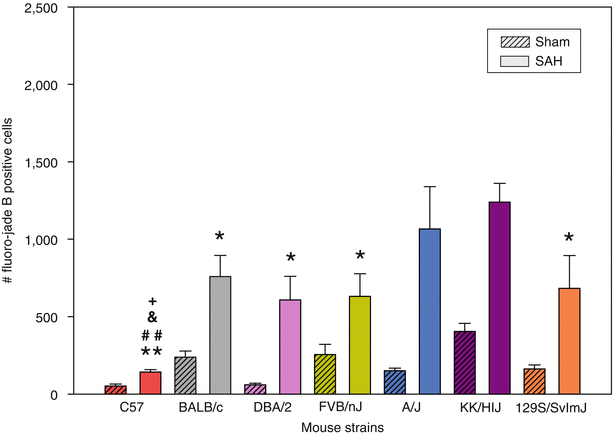Fig. 1
MCA vasospasm in seven inbred mouse strains after sham and SAH surgery. Data expressed as mean MCA radius/wall thickness ratio ± SEM, * P < 0.05, n = 5 control and 5 SAH/strain
Neuronal Degeneration
All SAH animals exhibited fluoro-jade B-positive cells in molecular layers 1 and 2 of the cerebral cortex and in the hippocampus and dentate gyrus. Sham animals had few to no fluoro-jade B-positive cells present. All SAH animals differed significantly from sham controls (Student’s t-test, P < 0.05). KK/HIJ mice had the greatest number of damaged neurons, whereas C57BL/6J mice had the least amount of brain damage (Fig. 2). Across strains, the difference in brain damage differed significantly between KK/HIJ and BALB/c, DBA/2J, FVB/NJ, and 129S1/SvImJ mice (ANOVA, Fisher LSD, P < 0.05) and C57BL/6J mice (P < 0.001). C57BL/6J mice also differed from A/J (P < 0.001), BALB/c, and 129S1/SvImJ mice (P < 0.05, Fig. 2).


Fig. 2
Total number of fluoro-jade B-positive cells in coronal sections of seven inbred mouse strains after sham or SAH surgery. Data expressed as mean ± SEM, * P < 0.05 compared with KK/HIJ, ** P < 0.001 compared with KK/HIJ, ## P < 0.05 compared with A/J, and P < 0.05 compared with BALB/c, + P < 0.05 compared with 129S1/SvImJ, ANOVA (Fisher LSD), n = 5 control and 5 SAH/strain
Discussion
Previous work in ischemic stroke has demonstrated that inherent genetic differences in mice can contribute to differences in cerebral infarction [6]. Other studies have also identified differences across mouse strains in performance during the Morris water maze [17], neurogenesis [16], and natural brain and vascular anatomy [1, 4, 7, 10, 11, 17, 20]. Here we show that genetic background in seven inbred mouse strains can contribute to variation in the severity of aVSP and neuronal injury after experimental SAH.
In the current experiments, aVSP and brain injury were assessed in C57BL/6J, BALB/c, DBA/2J, FVB/NJ, A/J, KK/HIJ, and 129S1/SvImJ mouse strains. Forty-eight hours after SAH, strains showed differences in the severity of MCA VSP. All strains differed significantly from sham controls, except DBA/2J and KK/HIJ mouse strains (Student’s t-test, P < 0.05). 129S1/SvImJ mice had the least aVSP (largest MCA radius/wall thickness ratio), whereas FVB/NJ mice had the greatest aVSP (smallest MCA radius/wall thickness ratio); however, these differences were not statistically significant (Fig. 1). Differences across strains were also observed in terms of the total number of fluoro-jade B-positive neurons. All mice differed significantly from sham controls, with KK/HIJ and C57BL/6J mice showing the most and least neuronal degeneration, respectively (ANOVA, Fisher LSD, P < 0.05; Fig. 2).
These underlying strain characteristics have important implications for the conduct of studies using mouse models. These findings suggest that because differences in VSP and brain injury have at least some genetic basis, experimental findings between different mouse strains should be compared with caution. Also, although transgenic technology is useful for the study of specific gene function, these mice are often a hybrid of multiple strains. Therefore, the amalgamation of traits may alter the reported levels of aVSP or neuronal injury, rather than what may be seen in the strain’s natural state. It is suggested that backcrossing over 12 generations can eliminate genetic heterogeneities; however, this may not be sufficient if genes responsible for stroke sensitivity are located close to the mutated genes of interest [5]. Therefore, avoiding interstrain crosses may give the truest representation of results.
Across numerous mouse studies, the C57BL/6J strain tends to be more successful at enduring injury compared with other strains [6, 8, 11, 17]. This has implications for future experimental models. The C57BL/6J strain is most common in SAH studies, so the degree of brain injury and aVSP detected may be less than if other strains were used. Identifying the most appropriate strain to model human SAH is important for translational studies. It is possible that a strain exhibiting more brain injury may be a better representation of clinical SAH because approximately 10–15 % of patients with spontaneous aneurysmal SAH die before reaching the hospital [19]. More importantly, identifying the genetic basis for the variation in aVSP and brain injury between strains may lead to insight into the pathogenesis of these complications and potentially even to treatments for SAH.
Conclusion
Mouse genetic background can influence the degree of brain injury and aVSP after experimental SAH. FVB/NJ and 129S1/SvImJ mice had the most and least severe aVSP, while KK/HIJ and C57BL/6J had the most and least neuronal damage, respectively. These findings are important for animal modeling of disease, and suggest that the mouse strain used may alter the results of SAH studies. Identifying the appropriate strain to model human SAH is essential for translation from bench-to-bedside. Future investigations into the genetic factors that modify brain injury and aVSP across mouse strains may strengthen our understanding of secondary complications after clinical SAH.
Stay updated, free articles. Join our Telegram channel

Full access? Get Clinical Tree






